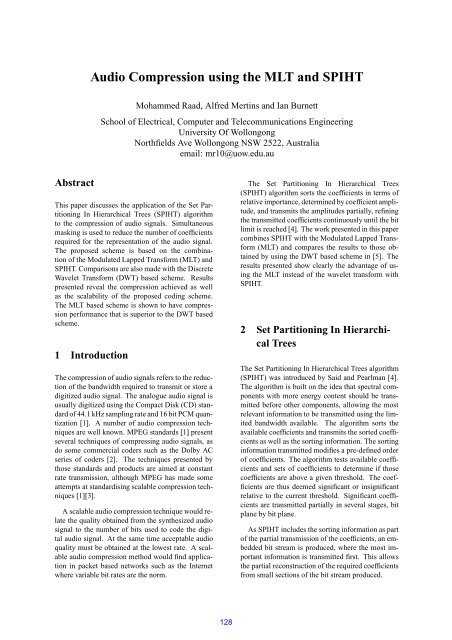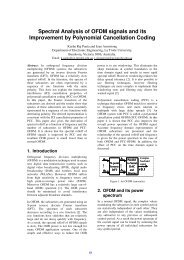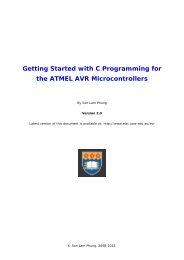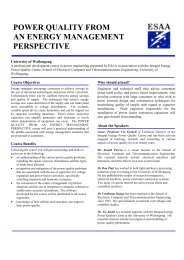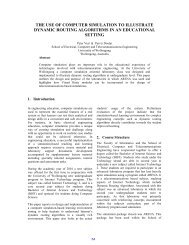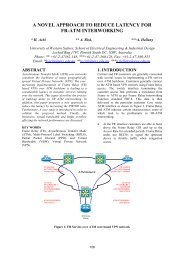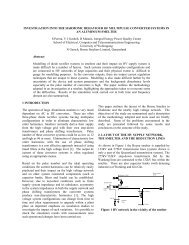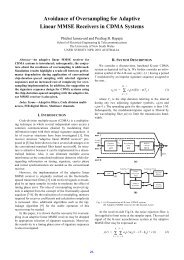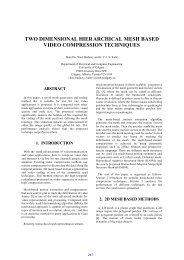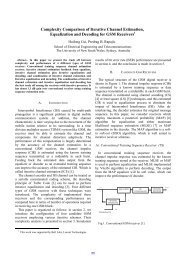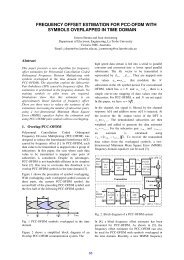Audio Compression using the MLT and SPIHT - University of ...
Audio Compression using the MLT and SPIHT - University of ...
Audio Compression using the MLT and SPIHT - University of ...
Create successful ePaper yourself
Turn your PDF publications into a flip-book with our unique Google optimized e-Paper software.
<strong>Audio</strong> <strong>Compression</strong> <strong>using</strong> <strong>the</strong> <strong>MLT</strong> <strong>and</strong> <strong>SPIHT</strong><br />
Mohammed Raad, Alfred Mertins <strong>and</strong> Ian Burnett<br />
School <strong>of</strong> Electrical, Computer <strong>and</strong> Telecommunications Engineering<br />
<strong>University</strong> Of Wollongong<br />
Northfields Ave Wollongong NSW 2522, Australia<br />
email: mr10@uow.edu.au<br />
Abstract<br />
This paper discusses <strong>the</strong> application <strong>of</strong> <strong>the</strong> Set Partitioning<br />
In Hierarchical Trees (<strong>SPIHT</strong>) algorithm<br />
to <strong>the</strong> compression <strong>of</strong> audio signals. Simultaneous<br />
masking is used to reduce <strong>the</strong> number <strong>of</strong> coefficients<br />
required for <strong>the</strong> representation <strong>of</strong> <strong>the</strong> audio signal.<br />
The proposed scheme is based on <strong>the</strong> combination<br />
<strong>of</strong> <strong>the</strong> Modulated Lapped Transform (<strong>MLT</strong>) <strong>and</strong><br />
<strong>SPIHT</strong>. Comparisons are also made with <strong>the</strong> Discrete<br />
Wavelet Transform (DWT) based scheme. Results<br />
presented reveal <strong>the</strong> compression achieved as well<br />
as <strong>the</strong> scalability <strong>of</strong> <strong>the</strong> proposed coding scheme.<br />
The <strong>MLT</strong> based scheme is shown to have compression<br />
performance that is superior to <strong>the</strong> DWT based<br />
scheme.<br />
1 Introduction<br />
The compression <strong>of</strong> audio signals refers to <strong>the</strong> reduction<br />
<strong>of</strong> <strong>the</strong> b<strong>and</strong>width required to transmit or store a<br />
digitized audio signal. The analogue audio signal is<br />
usually digitized <strong>using</strong> <strong>the</strong> Compact Disk (CD) st<strong>and</strong>ard<br />
<strong>of</strong> 44.1 kHz sampling rate <strong>and</strong> 16 bit PCM quantization<br />
[1]. A number <strong>of</strong> audio compression techniques<br />
are well known. MPEG st<strong>and</strong>ards [1] present<br />
several techniques <strong>of</strong> compressing audio signals, as<br />
do some commercial coders such as <strong>the</strong> Dolby AC<br />
series <strong>of</strong> coders [2]. The techniques presented by<br />
those st<strong>and</strong>ards <strong>and</strong> products are aimed at constant<br />
rate transmission, although MPEG has made some<br />
attempts at st<strong>and</strong>ardising scalable compression techniques<br />
[1][3].<br />
A scalable audio compression technique would relate<br />
<strong>the</strong> quality obtained from <strong>the</strong> syn<strong>the</strong>sized audio<br />
signal to <strong>the</strong> number <strong>of</strong> bits used to code <strong>the</strong> digital<br />
audio signal. At <strong>the</strong> same time acceptable audio<br />
quality must be obtained at <strong>the</strong> lowest rate. A scalable<br />
audio compression method would find application<br />
in packet based networks such as <strong>the</strong> Internet<br />
where variable bit rates are <strong>the</strong> norm.<br />
The Set Partitioning In Hierarchical Trees<br />
(<strong>SPIHT</strong>) algorithm sorts <strong>the</strong> coefficients in terms <strong>of</strong><br />
relative importance, determined by coefficient amplitude,<br />
<strong>and</strong> transmits <strong>the</strong> amplitudes partially, refining<br />
<strong>the</strong> transmitted coefficients continuously until <strong>the</strong> bit<br />
limit is reached [4]. The work presented in this paper<br />
combines <strong>SPIHT</strong> with <strong>the</strong> Modulated Lapped Transform<br />
(<strong>MLT</strong>) <strong>and</strong> compares <strong>the</strong> results to those obtained<br />
by <strong>using</strong> <strong>the</strong> DWT based scheme in [5]. The<br />
results presented show clearly <strong>the</strong> advantage <strong>of</strong> <strong>using</strong><br />
<strong>the</strong> <strong>MLT</strong> instead <strong>of</strong> <strong>the</strong> wavelet transform with<br />
<strong>SPIHT</strong>.<br />
2 Set Partitioning In Hierarchical<br />
Trees<br />
The Set Partitioning In Hierarchical Trees algorithm<br />
(<strong>SPIHT</strong>) was introduced by Said <strong>and</strong> Pearlman [4].<br />
The algorithm is built on <strong>the</strong> idea that spectral components<br />
with more energy content should be transmitted<br />
before o<strong>the</strong>r components, allowing <strong>the</strong> most<br />
relevant information to be transmitted <strong>using</strong> <strong>the</strong> limited<br />
b<strong>and</strong>width available. The algorithm sorts <strong>the</strong><br />
available coefficients <strong>and</strong> transmits <strong>the</strong> sorted coefficients<br />
as well as <strong>the</strong> sorting information. The sorting<br />
information transmitted modifies a pre-defined order<br />
<strong>of</strong> coefficients. The algorithm tests available coefficients<br />
<strong>and</strong> sets <strong>of</strong> coefficients to determine if those<br />
coefficients are above a given threshold. The coefficients<br />
are thus deemed significant or insignificant<br />
relative to <strong>the</strong> current threshold. Significant coefficients<br />
are transmitted partially in several stages, bit<br />
plane by bit plane.<br />
As <strong>SPIHT</strong> includes <strong>the</strong> sorting information as part<br />
<strong>of</strong> <strong>the</strong> partial transmission <strong>of</strong> <strong>the</strong> coefficients, an embedded<br />
bit stream is produced, where <strong>the</strong> most important<br />
information is transmitted first. This allows<br />
<strong>the</strong> partial reconstruction <strong>of</strong> <strong>the</strong> required coefficients<br />
from small sections <strong>of</strong> <strong>the</strong> bit stream produced.
Wavelet<br />
Transform<br />
Filters<br />
Quantization<br />
<strong>SPIHT</strong><br />
<strong>Audio</strong><br />
FFT<br />
Psychoacoustic<br />
Model<br />
Bit<br />
Allocation<br />
Side<br />
Info<br />
Figure 1: The wavelet based coding scheme<br />
3 The compression schemes used<br />
3.1 The use <strong>of</strong> wavelets with <strong>SPIHT</strong><br />
The wavelet transform has been combined with<br />
<strong>SPIHT</strong> in [5] to compress audio. The attractive property<br />
<strong>of</strong> <strong>the</strong> wavelet transform is <strong>the</strong> fact that <strong>the</strong> transform<br />
is implemented in a tree structure <strong>and</strong> so <strong>the</strong><br />
sets (or trees) originally developed in [4] could still<br />
be used. The filter pairs used in [5] were <strong>the</strong> 20-<br />
length Daubechies filter pairs.The sets that are required<br />
for <strong>SPIHT</strong> can be developed as given in [6].<br />
The scheme based on <strong>the</strong> wavelet transform is<br />
diagrammatically represented by Figure 1. In <strong>the</strong><br />
scheme shown, <strong>the</strong> psycho acoustic model determines<br />
<strong>the</strong> bit allocation that should be used in <strong>the</strong><br />
quantization <strong>of</strong> <strong>the</strong> wavelet coefficients. This requires<br />
side information to be transmitted. The results<br />
presented by Lu <strong>and</strong> Pearlman indicated that imperceptible<br />
distortion in <strong>the</strong> syn<strong>the</strong>sized signal could be<br />
obtained at bit rates between 55-66 kbps [5].<br />
As an indication <strong>of</strong> how <strong>SPIHT</strong> reduces <strong>the</strong> bits<br />
required, Table 1 lists initial results for <strong>the</strong> eight test<br />
signals used in this work coded <strong>using</strong> a maximum <strong>of</strong><br />
16 bits per coefficient. The test signals are Sound<br />
Quality Assessment Material (SQAM) signals obtained<br />
from [7]. The signal content <strong>of</strong> <strong>the</strong> files tested<br />
is also given in Table 1. The results given are in terms<br />
<strong>of</strong> average bit rates per frame <strong>and</strong> should be compared<br />
to 706 kbps which is <strong>the</strong> CD rate. Since this set<br />
<strong>of</strong> results is for complete reconstruction combined<br />
with bit allocation <strong>using</strong> <strong>the</strong> MPEG masking model,<br />
<strong>the</strong> sound quality <strong>of</strong> <strong>the</strong> syn<strong>the</strong>sized files were <strong>the</strong><br />
same as <strong>the</strong> original. The objective results given are<br />
<strong>the</strong> Segmental Signal to Noise Ratios (SegSNRs) <strong>of</strong><br />
<strong>the</strong> syn<strong>the</strong>sised signals.<br />
Figure 2: The codec used<br />
The results presented in Table 1 are for complete<br />
reconstruction. It was found that <strong>the</strong> described DWT<br />
based scheme may be used to code <strong>the</strong> SQAM files at<br />
lower bit rates than those listed with good results. In<br />
fact at bit rates between 42 <strong>and</strong> 64 kbps, most <strong>of</strong> <strong>the</strong><br />
syn<strong>the</strong>sized audio had almost no perceivable distortion<br />
which is in agreement with <strong>the</strong> results presented<br />
in [5].<br />
3.2 The <strong>MLT</strong> combined with <strong>SPIHT</strong><br />
The codec based on <strong>the</strong> combination <strong>of</strong> <strong>the</strong> <strong>MLT</strong> with<br />
<strong>SPIHT</strong> is shown in Figure 2. In Figure 2, <strong>the</strong> audio<br />
signal is divided into overlapping frames <strong>and</strong> <strong>the</strong><br />
<strong>MLT</strong> is applied to each frame. The obtained coefficients<br />
are subjected to <strong>the</strong> Johnston psycho acoustic<br />
model [8] <strong>and</strong> any coefficients that are found to be<br />
below <strong>the</strong> masking threshold are set to zero before<br />
scalar quantization is carried out on all <strong>of</strong> <strong>the</strong> coefficients.<br />
The quantized coefficients are transmitted by<br />
<strong>the</strong> use <strong>of</strong> <strong>SPIHT</strong>. At <strong>the</strong> decoder, <strong>SPIHT</strong> is used to<br />
decode <strong>the</strong> bit stream received <strong>and</strong> <strong>the</strong> inverse transform<br />
is used to obtain <strong>the</strong> syn<strong>the</strong>sized audio.<br />
3.2.1 Setting up <strong>the</strong> <strong>SPIHT</strong> sets<br />
In applying <strong>the</strong> <strong>MLT</strong> to an <strong>SPIHT</strong> based codec, <strong>the</strong><br />
sets that were used for <strong>the</strong> wavelet based coding<br />
scheme no longer describe <strong>the</strong> relationship between<br />
<strong>the</strong> transform coefficients appropriately. In [4] sets<br />
are based on <strong>the</strong> tree structure organization <strong>of</strong> <strong>the</strong><br />
coefficients, whereas <strong>the</strong> uniform M-b<strong>and</strong> decomposition<br />
carried out by <strong>the</strong> <strong>MLT</strong> is a parallel operation.
Table 1: Coding Results <strong>using</strong> <strong>the</strong> Wavelet Transform.<br />
Signal Content SegSNR (dB) Mean Rate (kbps)<br />
x1 Bass 46.1 167<br />
x2 Electronic Tune 50.9 71<br />
x3 Glockenspiel 46.6 180<br />
x4 Glockenspiel 44.4 201<br />
x5 Harpsichord 31.1 227<br />
x6 Horn 48.0 94<br />
x7 Quartet 43.2 174<br />
x8 Soprano 43.7 162<br />
There has been a reported work that used <strong>the</strong> tree<br />
structure based sets on a non-tree structured transform<br />
[9] in image compression with very good results.<br />
This indicates that as long as <strong>the</strong> trees define<br />
large sets <strong>of</strong> insignificant coefficients <strong>and</strong> small sets<br />
<strong>of</strong> significant coefficients, <strong>SPIHT</strong> will not use an excessive<br />
amount <strong>of</strong> bits to carry out <strong>the</strong> sorting.<br />
In <strong>the</strong> following we define <strong>SPIHT</strong> sets that link toge<strong>the</strong>r<br />
<strong>the</strong> frequency domain coefficients for a given<br />
frame. The roots <strong>of</strong> <strong>the</strong> used sets are at <strong>the</strong> low frequency<br />
end <strong>of</strong> <strong>the</strong> spectrum <strong>and</strong> <strong>the</strong> outer leaves are<br />
at <strong>the</strong> higher end <strong>of</strong> <strong>the</strong> spectrum. Thus, <strong>the</strong> sets<br />
link toge<strong>the</strong>r coefficients in <strong>the</strong> frequency domain in<br />
an order that fits <strong>the</strong> expectation that <strong>the</strong> lower frequency<br />
coefficients should contain more energy than<br />
<strong>the</strong> higher frequency coefficients. This ordering is<br />
similar to, although not <strong>the</strong> same as, <strong>the</strong> sets defined<br />
in [4].<br />
In this implementation <strong>the</strong> sets are developed by<br />
assuming that <strong>the</strong>re are Æ roots. One <strong>of</strong> <strong>the</strong> roots<br />
is <strong>the</strong> DC-coefficient <strong>and</strong> because it is not related to<br />
any <strong>of</strong> <strong>the</strong> o<strong>the</strong>r coefficients in terms <strong>of</strong> multiples <strong>of</strong><br />
frequency, it is not given any <strong>of</strong>fspring. Each <strong>of</strong> <strong>the</strong><br />
remaining Æ ½ roots are assigned Æ <strong>of</strong>fsprings.<br />
In <strong>the</strong> next step each <strong>of</strong> <strong>the</strong> <strong>of</strong>fsprings is assigned Æ<br />
<strong>of</strong>fsprings <strong>and</strong> so on, until <strong>the</strong> number <strong>of</strong> <strong>the</strong> available<br />
coefficients is exhausted. The <strong>of</strong>fsprings <strong>of</strong> any<br />
node ´µ where ´µ varies between ½ <strong>and</strong> Å ½ (Å<br />
is <strong>the</strong> total number <strong>of</strong> coefficients <strong>and</strong> ¼ is <strong>the</strong><br />
DC coefficient), are defined as<br />
Ç´µ Æ · ¼Æ ½ (1)<br />
Any <strong>of</strong>fspring above Å ½ are ignored. The descendants<br />
<strong>of</strong> <strong>the</strong> roots are obtained by linking <strong>the</strong><br />
<strong>of</strong>fsprings toge<strong>the</strong>r. For example, if Æ , node<br />
number ½ will have <strong>of</strong>fsprings 4,5,6,7, node will<br />
have <strong>of</strong>fsprings 16,17,18,19 <strong>and</strong> <strong>the</strong> descendants<br />
<strong>of</strong> node ½ will include 4, 5, 6, 7, 16, 17, 18, 19,....<br />
As part <strong>of</strong> <strong>the</strong> development <strong>of</strong> <strong>the</strong> M-b<strong>and</strong> transform<br />
plus <strong>SPIHT</strong> coding system, a number <strong>of</strong> experiments<br />
were conducted to determine if <strong>the</strong> size <strong>of</strong> Æ<br />
Mean number <strong>of</strong> bits used<br />
3200<br />
3000<br />
2800<br />
2600<br />
2400<br />
2200<br />
x5<br />
x1<br />
x9<br />
x12<br />
2000<br />
2 4 6 8 10 12<br />
N<br />
Figure 3: The mean number <strong>of</strong> bits required as functions<br />
<strong>of</strong> Æ for various audio files<br />
affects <strong>the</strong> performance <strong>of</strong> <strong>the</strong> coder. Figure 3 shows<br />
<strong>the</strong> results <strong>of</strong> some <strong>of</strong> <strong>the</strong>se experiments. Figure 3 indicates<br />
that <strong>the</strong> use <strong>of</strong> Æ is better than or equivalent<br />
to <strong>the</strong> use <strong>of</strong> any o<strong>the</strong>r value. This result can be<br />
explained by <strong>the</strong> way in which <strong>SPIHT</strong> performs <strong>the</strong><br />
sorting. If a compromise between a few large sets<br />
<strong>and</strong> many smaller sets is obtained one would expect<br />
<strong>SPIHT</strong> to perform better than in ei<strong>the</strong>r extreme case.<br />
This is because <strong>SPIHT</strong> gains from identifying large<br />
insignificant sets as well as having small significant<br />
sets. Æ presents such a compromise.<br />
3.2.2 The <strong>MLT</strong><br />
The <strong>MLT</strong> is a uniform M-channel filter bank. In traditional<br />
block transform <strong>the</strong>ory, a signal Ü´Òµ is divided<br />
into blocks <strong>of</strong> length Å <strong>and</strong> is transformed by<br />
<strong>the</strong> use <strong>of</strong> an orthogonal matrix <strong>of</strong> order Å. More<br />
general filter banks take a block <strong>of</strong> length Ä <strong>and</strong><br />
transform that block into Å coefficients, with <strong>the</strong>
Table 2: Coding Results <strong>using</strong> <strong>the</strong> <strong>MLT</strong>.<br />
Full Reconstruction Partial Reconstruction with Masking<br />
Signal SegSNR (dB) Mean Rate (kbps) SegSNR (dB) Mean Rate (kbps)<br />
x1 55.5 145 16.7 53<br />
x2 64.2 31 19.2 14<br />
x3 49.4 60 17.9 25<br />
x4 54.1 110 21.8 47<br />
x5 45.8 183 7.6 65<br />
x6 61.1 68 23.3 33<br />
x7 55.5 180 20.1 65<br />
x8 54.2 140 21.4 47<br />
condition that ÄÅ[10]. In order to perform this<br />
operation <strong>the</strong>re must be an overlap between consecutive<br />
blocks <strong>of</strong> Ä Å samples [10]. This means that<br />
<strong>the</strong> syn<strong>the</strong>sized signal must be obtained by <strong>the</strong> use<br />
<strong>of</strong> consecutive blocks <strong>of</strong> transformed coefficients.<br />
In <strong>the</strong> case <strong>of</strong> <strong>the</strong> modulated lapped transform Ä is<br />
equal to ¾Å <strong>and</strong> <strong>the</strong> overlap is thus Å. The basis<br />
functions <strong>of</strong> <strong>the</strong> <strong>MLT</strong> are given by:<br />
´Ò Å · ·½<br />
µ´ · ½ ¾<br />
¾ µ Å<br />
(2)<br />
where ¼ ¡¡¡ Å ½ <strong>and</strong> Ò ¼ ¡¡¡ ¾Å ½<br />
Ò ´ÒµÖ<br />
¾<br />
Å Ó× <br />
The window chosen is ´Òµ ×Ò´´Ò · ½<br />
¾ µ <br />
¾Å µ.<br />
<br />
4 Conclusion<br />
This paper has presented a comparison between two<br />
schemes <strong>of</strong> audio compression based on <strong>SPIHT</strong>. The<br />
results show clearly that significant savings may be<br />
obtained if <strong>the</strong> Modulated Lapped Transform is used<br />
in place <strong>of</strong> <strong>the</strong> Wavelet transform. The most significant<br />
savings are obtained when <strong>the</strong> Johnston technique<br />
<strong>of</strong> determining masked components is combined<br />
with <strong>the</strong> <strong>MLT</strong> based scheme. The results presented<br />
have also highlighted <strong>the</strong> usefulness <strong>of</strong> <strong>the</strong><br />
<strong>SPIHT</strong> algorithm, combined with relevant transform<br />
coefficient relationships, to scalable audio coding, as<br />
<strong>the</strong> algorithm is designed with <strong>the</strong> aim <strong>of</strong> producing<br />
an embedded bit stream.<br />
3.2.3 Results <strong>of</strong> combining <strong>the</strong> <strong>MLT</strong> with<br />
<strong>SPIHT</strong><br />
Table 2 shows <strong>the</strong> obtained results for complete reconstruction.<br />
The results shows that almost all <strong>of</strong><br />
<strong>the</strong> SQAM files are coded <strong>using</strong> a lower mean rate<br />
than when <strong>the</strong> DWT is used, this is indicated by bold<br />
font values in <strong>the</strong> table. Also, note <strong>the</strong> high SegSNR<br />
results which illustrate <strong>the</strong> resilience <strong>of</strong> <strong>the</strong> <strong>MLT</strong> to<br />
quantization noise. The results in Table 2 are obtained<br />
with <strong>and</strong> without <strong>the</strong> use <strong>of</strong> <strong>the</strong> simultaneous<br />
masking.<br />
The results presented in Table 2 are for <strong>the</strong> syn<strong>the</strong>sized<br />
signals that are indistinguishable from <strong>the</strong> original.<br />
The reduction in b<strong>and</strong>width is very significant<br />
when <strong>the</strong> masking model is included in <strong>the</strong> coding,<br />
justifying <strong>the</strong> use <strong>of</strong> <strong>the</strong> psycho- acoustic model in<br />
<strong>the</strong> manner described.<br />
The results show that at a rate <strong>of</strong> 65 kbps almost<br />
all <strong>of</strong> <strong>the</strong> SQAM signals tested may be reproduced<br />
to sound identical to <strong>the</strong> original. The <strong>MLT</strong> combined<br />
with simultaneous masking produces significant<br />
b<strong>and</strong>width savings <strong>and</strong> <strong>the</strong> addition <strong>of</strong> <strong>SPIHT</strong><br />
also adds <strong>the</strong> dimension <strong>of</strong> scalability to <strong>the</strong> scheme.<br />
At <strong>the</strong> 54 kbps mark almost all <strong>of</strong> <strong>the</strong> files had no<br />
audible or very little distortion in <strong>the</strong>m.<br />
Acknowledgements<br />
Mohammed Raad is in receipt <strong>of</strong> an Australian<br />
Postgraduate Award (industry) <strong>and</strong> a Motorola<br />
(Australia) Partnerships in Research Grant.<br />
References<br />
[1] Peter Noll, “Mpeg digital audio coding,” IEEE<br />
Signal Processing Magazine, vol. 14, no. 5, pp.<br />
59–81, Sept. 1997.<br />
[2] G.A. Davidson, Digital Signal Processing<br />
H<strong>and</strong>book, chapter 41, CRC Press LLC, 1999.<br />
[3] H. Purnhagen <strong>and</strong> N. Miene, “Hiln - <strong>the</strong> mpeg-<br />
4 parametric audio coding tools,” in Proceedings<br />
<strong>of</strong> ISCAS 2000, 2000, vol. 3, pp. 201–204.<br />
[4] Amir Said <strong>and</strong> William A. Pearlman, “A new,<br />
fast, <strong>and</strong> efficient image codec based on set partitioning<br />
in hierarchical trees,” IEEE Transactions<br />
on Circuits <strong>and</strong> Systems For Video Technology,<br />
vol. 6, no. 3, pp. 243–250, June 1996.<br />
[5] Zhitao Lu <strong>and</strong> William A. Pearlman, “An efficient,<br />
low-complexity audio coder delivering<br />
multiple levels <strong>of</strong> quality for interactive applications,”<br />
in 1998 IEEE Second Workshop on
Multimedia Signal Processing, 1998, pp. 529–<br />
534.<br />
[6] Zhitao Lu, Dong Youn Kim, <strong>and</strong> William A.<br />
Pearlman, “Wavelet compression <strong>of</strong> ecg signals<br />
by <strong>the</strong> set partitioning in hierarchical trees<br />
algorithm,” IEEE Transactions on Biomedical<br />
Engineering, vol. 47, no. 7, pp. 849–856, July<br />
2000.<br />
[7] “Mpeg web site at http://www.tnt.unihannover.de/project/mpeg/audio,”<br />
.<br />
[8] James D. Johnston, “Transform coding <strong>of</strong><br />
audio signals <strong>using</strong> perceptual noise criteria,”<br />
IEEE Journal On Selected Areas In Communications,<br />
vol. 6, no. 2, pp. 314–323, Feb. 1988.<br />
[9] T.D. Tran <strong>and</strong> T.Q. Nguyen, “A lapped transform<br />
progressive image coder,” in Proceedings<br />
<strong>of</strong> ISCAS 1998, 1998, vol. 4, pp. 1–4.<br />
[10] Henrique S. Malvar, Signal Processing with<br />
Lapped Transforms, Artec House, Inc., Boston,<br />
1992.


